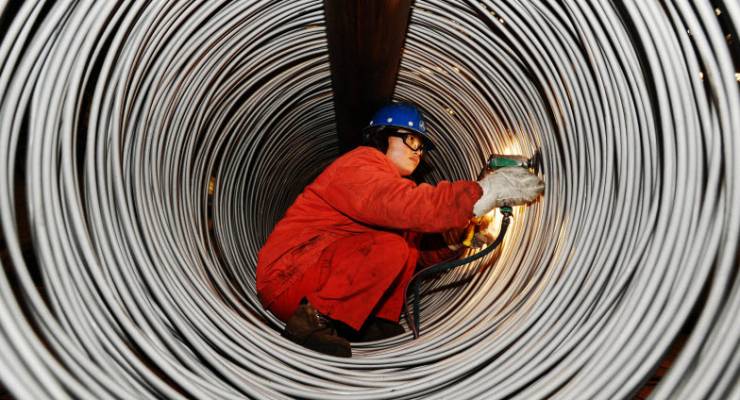
As President Donald Trump pushes headlong for some kind of stoush with China, most likely in the economic arena in the first instance, Australia should be afraid — very afraid.
But while the “Free World’s” bellicose new leader’s promised policies will take some time to impact globally, China’s own set of homegrown problems continues to inexorably mount — and now, at last, hard evidence has emerged of the extent of the ruling Communist Party’s statistical fudging.
Last week, China’s official economic growth figures came in. As predicted, well, they were just as predicted: 6.7% for the year. It was a spectacularly (some would say spookily) consistent performance for a country whose economic growth diverges wildly across its 31 provinces and four municipalities as not just the year, but even each quarter, delivered 6.7% or 6.8%.
To put that in context, that means collectively 1.3 billion people delivered precisely the same amount of product, on average — month in, month out — in a year where commodities prices surged, China’s debt mountain continued to pile up and its biggest export markets continued to struggle, which are all events that, in other countries, would have thrown a spanner in the economic works, causing volatile GDP growth rates.
There has been enormous — and growing — scepticism about much of the data that emerges from Beijing’s National Bureau of Statistics (NBS). Beijing, according to its own opaquely collated numbers, runs the only economy in the world where there are no surprises, only the occasional blip caused by external forces such as the global financial crisis.
There have been admissions from the NBS that it needs to improve its data collection. It is widely believed that Chinese figures at the top level are massaged to slow gradual rises and declines, connoting credible and solid economic management.
Now, news from the scandal-ridden north-eastern province of Liaoning — one of the epicentres of China’s problematic, massively over-capacity heavy industry, which the government has promised to slash and restructure — has belled the cat on Chinese stats.
Liaoning’s governor Chen Qiufa has admitted that from 2011 to 2014, economic data under the province’s jurisdiction was riddled with false statistics, China’s state-run news agency Xinhua said.
[‘Don’t mention this’: China’s economy is worse than you think]
Liaoning has warned by an inspection group from Beijing in 2014 about the “prevalence of economic data fraud”.
For example, in 2013 one Liaoning County reported revenues were 127% more than the actual figure, Xinhua reported.
In the first quarter of 2016, following the investigations, Liaoning became the first province in years to report negative growth, according to reports at the time.
But here’s the rub — the problems in Liaoning — i.e. the problematic shift away from old industries to new, the over reliance on infrastructure spending and property investment — reflect those in the country’s economy more generally. It is these industries that provide the second income streams to vested elite interest groups within the Communist Party’s corrupt hierarchy.
As well, the likelihood that Liaoning is the only province to have been submitting false data to Beijing beggars belief. In the real world, Liaoning — and most likely the rest of the three Dongbei (north-eastern) provinces, as well as other poorer parts of China — is in recession.
And there are no easy, painless fixes, as Xi Jinping must surely have come to realise by now. More than three years after the end of the 2013 party conference, at which the party issued a laundry list of economic reforms that would be undertaken by Xi’s administration, the promises remain just that.
A generation of Party officials is wedded to a second, corrupt income stream, the vested interests are deep and wide, and the opposition to any reform is considerable.
But the great unknown is Xi’s real commitment to making economic reforms that will inflict pain, first on his party colleagues but also on significant parts of the Chinese population as a whole. Fundamental reforms cannot happen without the party ceding some control and, this far, it has shown precisely the opposite tendency under Xi.
[She won’t be right: Australian economy will sink with China’s]
Surging commodity prices during 2016 should have been great news for Australia. While the US dollar strengthened considerably last year against most currencies, especially the Chinese renminbi yuan, the Australian dollar managed to hold its own — largely due to the unexpected increase in the prices for bulk commodities iron ore and coal (both in thermal coal used for power production and heating and coking/metallurgical coal used for steelmaking). Yet at the close of 2016, Australian growth abruptly slipped into the red.
So now we are even more certain that no matter what China’s pumped-up GDP growth numbers say, the country’s economy is in deep trouble. Whither goes China, goes most of the Asia-Pacific, with the Australian economy at the head of the queue.
Australia’s dumbfounded Treasurer Scott Morrison is no doubt scratching his thinning thatch and wondering why Australia’s economy appears to have stalled while its biggest customer is, apparently, still powering along. Here’s a tip: not swallowing China’s statistical obfuscation — and at Crikey we have long noted the Australian Treasury’s serial, hopeless record on China forecasting — would be a good place to start.
Only then can the government start to deal with the real world and not the parallel universe imagined by the armchair experts in the sterile corridors of Canberra.








Will China go the way of the Soviet Union?
If have read Michael’s comment correctly: Will Australia go the way of the Soviet Union?
Given how worthless such figures are in this country – constantly revised/corrected/readjusted – why does anyone believe the Chinese stats. are anything but fiction?